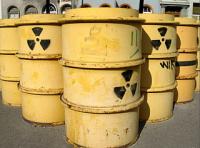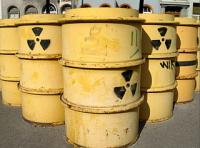2016-08-19 Nuclear accident in New Mexico ranks among the costliest in U.S. history
When a drum containing radioactive waste blew up in an underground nuclear dump in New Mexico two years ago, the Energy Department rushed to quell concerns in the Carlsbad desert community and quickly reported progress on resuming operations.
But the explosion ranks among the costliest nuclear accidents in U.S. history, according to a Times analysis. The long-term cost of the mishap could top $2 billion, an amount roughly in the range of the cleanup after the 1979 partial meltdown at the Three Mile Island nuclear power plant in Pennsylvania.
An Energy Department spokesperson declined to address the cost issue but acknowledged that the dump would either have to stay open longer or find a way to handle more waste each year to make up for the shutdown. She said the contract modification gave the government the option to cut short the agreement with Nuclear Waste Partnership.
It costs about $200 million a year to operate the dump, so keeping it open an additional seven years could cost $1.4 billion. A top scientific expert on the dump concurred with that assessment.
In addition, the federal government faces expenses — known as “hotel costs” — to temporarily store the waste before it is shipped to New Mexico, said Ellis Eberlein of Washington’s Department of Ecology.
The Hanford site stores the equivalent of 24,000 drums of waste that must be inspected every week. “You have to make sure nothing leaks,” he said.
Hancock suggested that the dump might never resume full operations.
“The facility was never designed to operate in a contaminated state,” he said. “It was supposed to open clean and stay clean, but now it will have to operate dirty. Nobody at the Energy Department wants to consider the potential that it isn't fixable.”
Giving up on the New Mexico dump would have huge environmental, legal and political ramifications. This year the Energy Department decided to dilute 6 metric tons of surplus plutonium in South Carolina and send it to the dump, potentially setting a precedent for disposing of bomb-grade materials. The U.S. has agreements with Russia on mutual reductions of plutonium.
The decision means operations at the dump must resume, said Edwin Lyman, a physicist and nuclear expert at the Union of Concerned Scientists.
“They have no choice,” he said. “No matter what it costs.”
2016-08-19 Nuclear accident in New Mexico ranks among the costliest in U.S. history
Some people imagine that 'diluting' plutonium makes it safe. Moreover, with the declining availability of U235, they also want to use it as part of 'mixed oxide' fuel (MOX).
When a drum containing radioactive waste blew up in an underground nuclear dump in New Mexico two years ago, the Energy Department rushed to quell concerns in the Carlsbad desert community and quickly reported progress on resuming operations.But the explosion ranks among the costliest nuclear accidents in U.S. history, according to a Times analysis. The long-term cost of the mishap could top $2 billion, an amount roughly in the range of the cleanup after the 1979 partial meltdown at the Three Mile Island nuclear power plant in Pennsylvania.

Recent articles
2024-07-12 The Road to Net Zero Can Save Government Funds
Action Government SavingRemove government funding of Sizewell C, SMR, ANF and FNEF £ 1155 millionRemove government funding of nuclear fusion Up to £ 650 million to 2027Remove tax relief for the oil and gas industry Up to £ 5.7 billion/y from 2022 to 2025Remove government funding of CCS £ 20 billion over 20 years from 2023Remove government funding of imported biomass for Drax etc £ 606.8 million in 2022Total of above About £ 8.6 billion a year2024-10-12 A Note on Climate and Energy
I watched videos on climate change by Professors Johan Rockstroem and Stefan Rahmsdorf of the Potsdam Climatological Institute in Germany.This prompted me to create the document ‘2024-10-12 A Note on Climate and Energy’.2024-09-17 Britain’s Atomic Bomb Scandal (Channel 4 programme)
Channel 4 made a multi-part series of programmes with this title.The sub-title was: The dramatic, shocking story of Britain’s race for the nuclear bomb, the devastating fallout for the servicemen at the tests, and the veterans’ long fight for justice'. I watched all the parts, and made notes.Then I typed up the notes and followed up mentions and links to produce this document.2021-09-29 Nuclear Power and the EU Taxonomy
Around September 2021, the European Commission considered the inclusion of nuclear power in the taxonomy for future investments in energy. This was based on a single report from the European Joint Research Centre, which still has close links with the nuclear industry and is widely perceived as playing a promoting role for nuclear energy within the European Union. The JRC Report ignored the report of the German Ethics Commission for a Safe Energy Supply of 2011, which had lead to Germany phasing out nuclear power by 2023. The European Commision also ignored 'Sustainability at risk, A critical analysis of the EU Joint Research Centre technical assessment of nuclear energy with respect to the "do no significant harm" criteria of the EU Taxonomy Regulation, of 2021-09 by Dr. Christoph Pistner, Dr. Matthias Englert and Dr. Ben Wealer, for the Heinrich Boell Foundation.2023-06-06 Nuclear Power Has No Future
The UK government proposes to build nuclear power plants totalling 24 GW.This implies Hinkley Point C, Sizewell C and about six more of similar size.The Labour party proposes to include nuclear power in it’s new ‘green’ energy policy.Yet nuclear power has no future, as shown in this document of 3 pages with 52 references. The first section shows that nuclear fuel may be effectively exhausted before 2050, when the climate targets should be met. The second section shows that the costs of nuclear power have risen over time, and are now uncompetitive. So nuclear power must be replaced by sustainable and affordable options such as energy savings and renewables like wind, solar and storage. The third section shows that nuclear power conflicts with energy savings and renewables, so impairing the business case and deterring investment.So the UK should phase out nuclear power and join the rest of the world in deploying energy savings and renewables.Although this document is published after the latest Government and Labour Party proposals,I have published many earlier documents on nuclear power, dating from 2006-0-19. (See below).Most notably, my report on the Fukushima disaster was published on 2012-04-11, with copies sent to several MPs and Ministers.2022-10-05 Nuclear Nonsense
The new UK government appears to support the previous government’s proposal of building new nuclear power plants. The Labour party proposes to include nuclear power in it’s new ‘green’ energy policy. However such nuclear proposals are nonsense, as shown in this 4-page due diligence assessment.2022-08-12 Stopping Sizewell C and all nuclear power in favour of a rational energy policy
Among the last acts of the Johnson government was the approval of a new nuclear plant - Sizewell C. The claim was that it would increase energy security and reduce carbon emissions. But the invasion of Ukraine has underlined that all nuclear sites are targets, and reduce national security. Also nuclear power would be far more costly than energy savings and renewable energy sources such as wind and solar, with storage, and could not be generating electricity before 2030. They need uranium for fuel, yet almost half comes from Russia and Kazachkstan, so that the money and carbon costs would increase twice as fast. Moreover, they require huge amounts of energy to manufacture and build, so reducing energy security until construction is complete, and this energy repaid. Yet Hinkley Point C and Sizewell C are coastal sites, at risk from flooding by sea level rise and storm surge by 2100. As decommissioning and site clearance would take at least 50 years, they would need to be shutdown before 2050. Many reasons for stopping Sizewell C and all nuclear power are given in this collection of five documents.2022-08-13 Nuclear Power And Weapons Are Killing Us
The Manhattan Project in the US covered every stage of the production of nuclear weapons. This included the mining and refining of uranium, enrichment to 80 to 90% U235 for uranium bombs, fuelling nuclear reactors with uranium to produce plutonium, and reprocessing the spent fuel to extract the plutonium for plutonium bombs. It was recognised from the beginning that these processes and plants would give rise to radioactive releases that would be harmful to the plant operators and the general public, yet they were never informed. This continues to the present day, when the nuclear weapon and power industry does everything in its power to deny and understate the many and extensive harms done to all living things. To this has been added the use of uranium in bunker-breaking bombs and tank-busting shells, that spread the dust so formed over their own forces, the enemy forces, and innocent bystanders, harming them all for generations to come. The human harms include many and extensive cancers, and also non-malignant diseases such as stillbirths, deformities and mental impairment and heart disease. With so much harm already done to humans that will take up to lifetimes to express, and so much nuclear debris laying in wait to harm even more humans, it is essential to identify every strategy and measure that can reduce the total harm.This document covers the first warnings of nuclear harms in the 1950s and - following studies beginning in the 1960s - five books of evidence by Dr Ernest Sternglass in 1981, Mr Harvey Wasserman et al in 1982, Dr John Gofman in 1990, Mr Paul Zimmerman in 2009, and Professor Chris Busby et al in 2010.2022-06-14 Energy Transition Technologies
This is prompted by the Energy Hierarchy of the Institution of Mechanical Engineers. From the most to the least sustainable, Tier 1 is Energy Demand Reduction, Tier 2 is Energy Efficiency, Tier 3 is Utilisation of Renewable, Sustainable Resources, Tier 4 is Utilisation of Other, Low-GHG-Emitting Resources, and Tier 5 is Utilisation of Conventional Resources as we do now.2022-06-18 Nuclear Insecurities
This is a three-page re-cast of 2016-08-09 Nuclear Insecurities (below).It includes 16 criteria under the original 10 headings, supported by 21 references.




